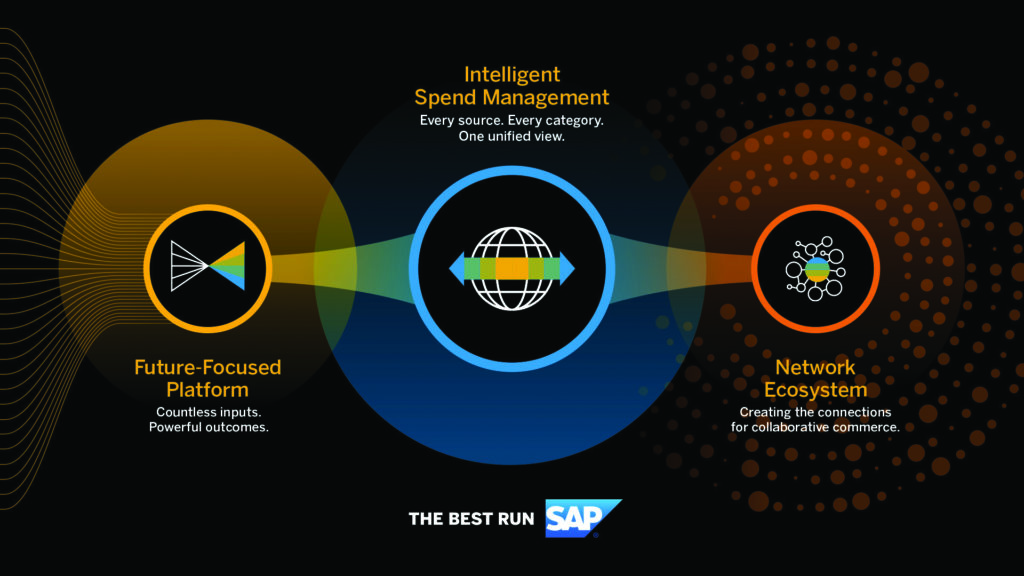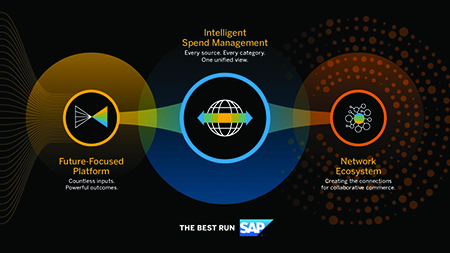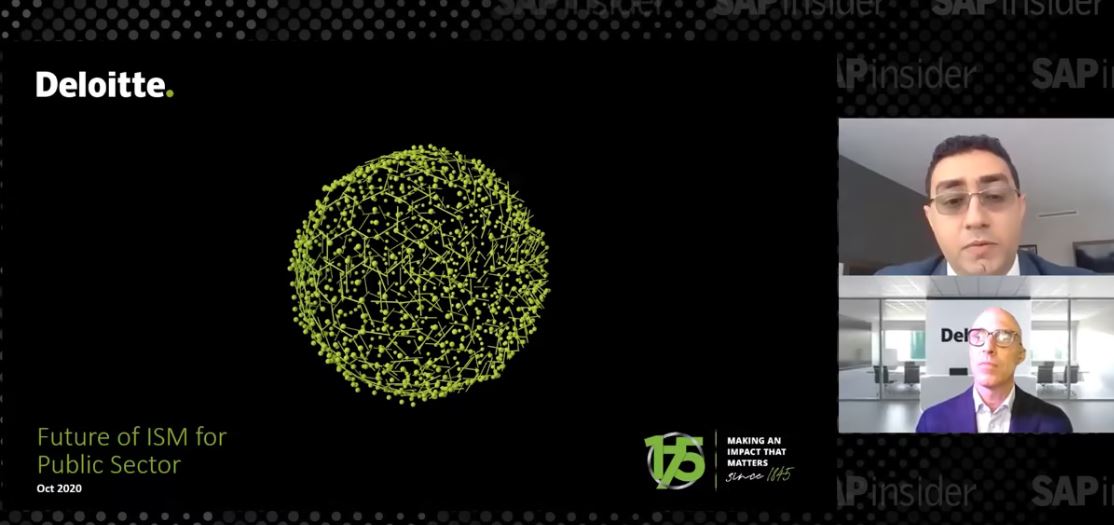The Next Evolution of Spend Management
SAP Offers a Comprehensive Approach that Ties Together Every Source and Category of Spend in One Unified View, Allowing SAP Customers to Apply Intelligent Technologies and Connect Outside Their Four Walls
by Drew Hofler, VP of SAP Ariba and SAP Fieldglass Portfolio Marketing, SAP
When it comes to how spend management is evolving, we are at a precipice. The first stage of the evolution was to eliminate the use of paper in every area possible in a move to “electronify” spend; then the focus advanced to automating processes to become more digitized in the procurement and supply chain area. Today, we are in the beginning stage of the next evolution, as we move toward Intelligent Spend Management where everything is integrated, insightful, and connected. And what SAP offers its customers in this space is an integrated solution suite for all spend management needs — with an adaptable, scalable platform that unifies spend management across every source and category of spend and infuses intelligent technologies into seamless end-to-end processes.
At the root of SAP’s integrated approach to Intelligent Spend Management are three pillars. The central pillar is the core of “every source, every category, one unified view.” The two supporting pillars that make the approach so powerful are the “future-focused platform” that infuses intelligence and allows for adaptability to business needs, and the “network ecosystem” that creates the connections for more collaborative commerce. (See Figure 1 for an illustration of the three pillars.) This article will dive into these pillars a bit more deeply, clear up some common misconceptions SAP customers have regarding spend management, and detail the benefits of adopting an Intelligent Spend Management strategy.

The Core of Intelligent Spend Management
The current state in spend management is that companies tend to manage different kinds of vendor spend in various applications and systems that are not integrated as part of a platform. In this sort of environment, each type of spend is treated differently and separately in silos, which prevents companies from working across categories or have transparency into where money is being spent. The core of Intelligent Spend Management is to look at every source of vendor spend, every category of spend, and have one unified view and approach to it — whether it’s travel spend, indirect spend (such as paper, desks, and computers), direct spend (such as maintenance, repair, and operating (MRO) supplies), or contingent labor and services spend.
Consider a project, such as building a new headquarters for a company. There is direct sourcing involved when it comes to certain critical materials for the building. There are also things like desks, chairs, computers, coffee machines and other indirect purchases. There are workers and subcontractors to hire in various roles. Along those lines, there is travel and expenses involved. This one project requires every type of spend, and Intelligent Spend Management allows businesses to bring it all together and manage it holistically — at a company layer, with various layers.
SAP’s strategy for Intelligent Spend Management is to offer a common platform that integrates processes and applications under one umbrella. So whether SAP customers use SAP Concur solutions for travel spend, SAP Fieldglass solutions for services and contingent spend, or SAP Ariba solutions and SAP S/4HANA for indirect and direct spend — regardless of the category or the source of spend — SAP has a best-in-class platform that ties together all those applications so customers can approach them holistically.
For example, customers can approach policy and supplier management holistically. Their supplier master data will be consistent across all their SAP systems so they won’t have to try to reconcile if one supplier — say IBM — in the SAP Ariba application is the same supplier that’s represented as “International Business Machines” in the SAP Concur application. SAP is helping customers reconcile their suppliers by horizontally tying this application data all together.
But at the same time, these systems were all purpose-built over many years and iterations geared toward particular types of spend and user experiences, according to the end-to-end business processes and the people responsible for completing them. For example, if workers need to perform sourcing activities for a strategic supplier, which requires a lot of complicated analysis and detailed integration with contracts, they would probably prefer to use a robust system to do that rather than a mobile phone. However, when booking travel or submitting expenses, they would prefer to do that right on their mobile device as opposed to some complex desktop environment. There’s intended flexibility here. And while there is a flexible user experience, there are certain user demands and variables that can complicate the spend management process. (See the sidebar at the end of the article, “External Workers and Consumer Expectations Complicate Spending” for more details.)
Now, that we’ve covered the strategy from an end-to-end process standpoint, next, let’s look more closely at the pillars that support the core.
The Importance of a Future-Focused Platform and a Collaborative Network Ecosystem
Intelligent Spend Management is built on an adaptable, scalable, future-focused platform (the second pillar), which essentially allows intelligent technologies to be infused throughout the system, applications, and processes. In addition to having purpose-built systems integrated on a common platform, SAP offers common analytics via SAP Analytics Cloud to provide a single view into customers’ supply base and spend. Customers can approach their analytics from a holistic manner as well, while allowing their users to interface with the spend data in the way that makes the most sense for them. And again, that’s across every source and every category of spend.
With Intelligent Spend Management, all an organization’s spend data is brought together and presented it in such a way that procurement, supply chain, and high-level finance leaders and business users can analyze the data directly to gain new insights and direction. The platform aspect of it also allows companies’ users to define specific processes using application programming interfaces (APIs) that allow them to customize a cloud solution for their specific needs. This is then connected to a global network ecosystem of solutions and trading partners that allows companies to extend their processes outside their four walls and connect with third-party applications, suppliers, and business partners. That’s the third pillar, which ties together the internal processes and then extends the reach of those processes and data externally.
Today’s businesses need to be nimble and able to find different sources of supply, get ratings on them, potentially switch out vendors, and minimize supplier and supply chain risks. The network ecosystem creates the connections for collaborative commerce and allows companies to extend processes outside of their applications and back-end systems to their suppliers and partners.
With the SAP Digital Supply Chain portfolio and Ariba Network, customers can extend collaborative capabilities to show when their inventory is going down, for example, and then the suppliers can verify they received the inventory signals by sending a revised schedule for providing the required stock. Or, on the source-to-pay process, companies can interact and collaborate back and forth with suppliers and partners outside their walls to send purchase orders, receive advance ship notices, receive invoices, and discuss early payment.
Additionally, organizations need to connect outside of their four walls to complementary partner solutions. The network ecosystem allows these types of solutions to be added to the mix — such as integrating Thompson Reuters data to get financial risk information or tapping into Celonis process mining technology to read and map out system processes to try to maximize efficiencies. While these areas aren’t SAP’s core expertise, our network ecosystem allows these complementary solutions to come on board. Finally, the network allows companies to pull in external data — such as supplier risk data, weather data, news data, or tax laws that matter to their processes — which is where intelligent technologies such as machine learning and artificial intelligence come into play. Pulling in that sort of information, combining it with spend data and historical supplier data, and then applying intelligent technologies to that information can start to show patterns so companies can predict when there might be risk in the supply chain, for example.
Say your organization plans are to produce 100,000 widgets by a certain date, for instance. Part of that plan depends on on-time delivery from suppliers of the raw materials you need. The plan might be to receive a major part from a supplier in Indonesia. However, you might start receiving information in news feeds that indicates some political unrest or protests there. Or perhaps weather data shows a typhoon is coming two days before this supplier is planning the shipment. With Intelligent Spend Management, customers will be able to get alerts of risks raised and can anticipate probable disruptions of shipments. You can’t get those insights without data from the outside and without the future-focused platform that allows you to utilize those intelligent technologies tied together into your processes that show where those risks could impact the process.
To sum up, Intelligent Spend Management is adaptable, scalable, and future-focused with intelligent technologies and APIs that allow companies to infuse intelligence throughout their processes and be able to analyze their data holistically. Taking the central pillar and combining it with the two supporting pillars, all that together is your holistic Intelligent Spend Management strategy.
Companies Can Begin Exactly Where They Are
One common misconception among SAP customers is that adopting an Intelligent Spend Management strategy means coming up with an overwhelming vision and tackling an elephant of a project. On the contrary, it’s an important distinction that Intelligent Spend Management is instead approachable in pieces. Companies can gain the benefit of this future-focused platform and the network ecosystem even if they are only focused on one type of spend for the moment. They can start wherever their current business problem lies, and then they can add in what they need afterward. While SAP’s Intelligent Spend Management approach is a comprehensive one, and while it can take your company into the next evolution of spend management for many years to come, you can begin where you are now.
SAP has a real advantage today in spend management because we bring together both a best-of-suite and best-of-breed platform. Each of the individual underlying applications is best of breed that has been built specifically for the type of spend and the type of user that is going to interface with it the most. And we tie the SAP applications together utilizing and leveraging the strength our landscape — SAP S/4HANA, the SAP Leonardo suite, SAP Cloud Platform, and all of the rest — and because we’re all part of one company, we can make these systems talk to each other natively on one common SAP platform. So from that standpoint, we are best of suite. And many people mistakenly think that “best of suite” means a monolithic experience is involved, whether you are doing sourcing, planning travel, or buying a computer. And it’s not. From a user and process perspective, we’ve built the interface and tailored the user experience to be unique to the specific user need in each process.
Benefits: Enabling Smarter, Quicker Investments in Growth
The benefits of Intelligent Spend Management include but aren’t limited to identifying opportunities for cost savings. An effective strategy allows companies to leverage data that illuminates areas in which long-term investment is most likely to lead to desired growth. Meanwhile, it enables faster investment decisions because the data-based roadmaps are less subjective and require less vetting.
With Intelligent Spend Management, companies can take data from multiple supply chains and analyze historical data around costs and price points in certain areas to help them understand the underlying costs of investing in that new product. They can ascertain very quickly how much it will cost, how likely it is that suppliers will deliver at particular times, and how all that works together.
The many benefits of adopting an Intelligent Spend Management approach include:
- Leaders can more effectively manage and control all spending via a closed loop of cross-category spending that’s automatically fed into supplier management systems to inform the next round of negotiation and contracts.
- Finance teams get one view of insight into spend and exposure across every category so they can reduce risks, uncover opportunities, identify and correct spending and policy errors in real time, and strike a balance of optimizing spend while increasing business agility.
- Front-line managers can use powerful ad-hoc analysis and predictive algorithms to spend more wisely.
- Business leaders receive up-to-date visibility into all key performance indicators (KPIs) helping them dive into action and fund innovation and growth as well as their core business.
- Administrators can see where spend is happening to easily find insights and ensure compliance, enabling total control of each category of spending as well as broader orchestration of spending and policy across categories.
- Companies can manage the entire travel request-to-reimbursement process with user-friendly tools that provide transparency, including using traveler location data to find employees and contractors to assist when they need help.
Manage Your Spend More Intelligently Today
SAP is the only company that can bring best-of-breed solutions into a comprehensive Intelligent Spend Management approach that ties together every source and every category with one unified view and allows you to apply intelligent technologies and collaborate with your partners outside of your four walls. To learn how to adopt an Intelligent Spend Management approach, engage with a value engineer today to analyze your spend and see exactly how you can drive significant bottom-line and top-line value to your organization. For more information, visit sap.com/intelligentspend.
Sidebar: External Workers and Consumer Expectations Complicate Spending
For many companies, significant portions of their workforce are external, which can complicate spend management. Whereas accounting for traditional on-site employees is straight-forward, with an external workforce, companies need to be able to flex them in and out of projects. They need to account for their whereabouts. Companies working with external workforces typically don’t know where all the people with access to their systems are or how long they’re supposed to have that access. The spend management concern with external workforces isn’t just about the contracted rates, although that’s a big part of it. It’s about automatically managing the services and the external workers – knowing where they are and their access to company systems.
Another variable that complicates spending is the consumer experience. The way today’s consumers purchase is very different from the ways that companies typically spend. If a company wants to enforce spending policies, one of the biggest barriers is making sure that the processes are user friendly. Otherwise, users will find ways around them. Intelligent Spend Management involves creating purpose-built user experiences that are consumer-like and appropriate for the type of spend it is. Consider travel and expense. Today’s users don’t want to go into a browser system on a laptop and jump through complicated hoops. They want a mobile app that allows them to automatically download receipts, easily send expense reports, and quickly get reimbursed. On the other hand, when it comes to direct spending or sourcing of core materials, users understand that’s not likely a job for a mobile app because more is needed in terms of approvals, research, and data. In this case, a robust system is needed, but it still needs to be very usable.






